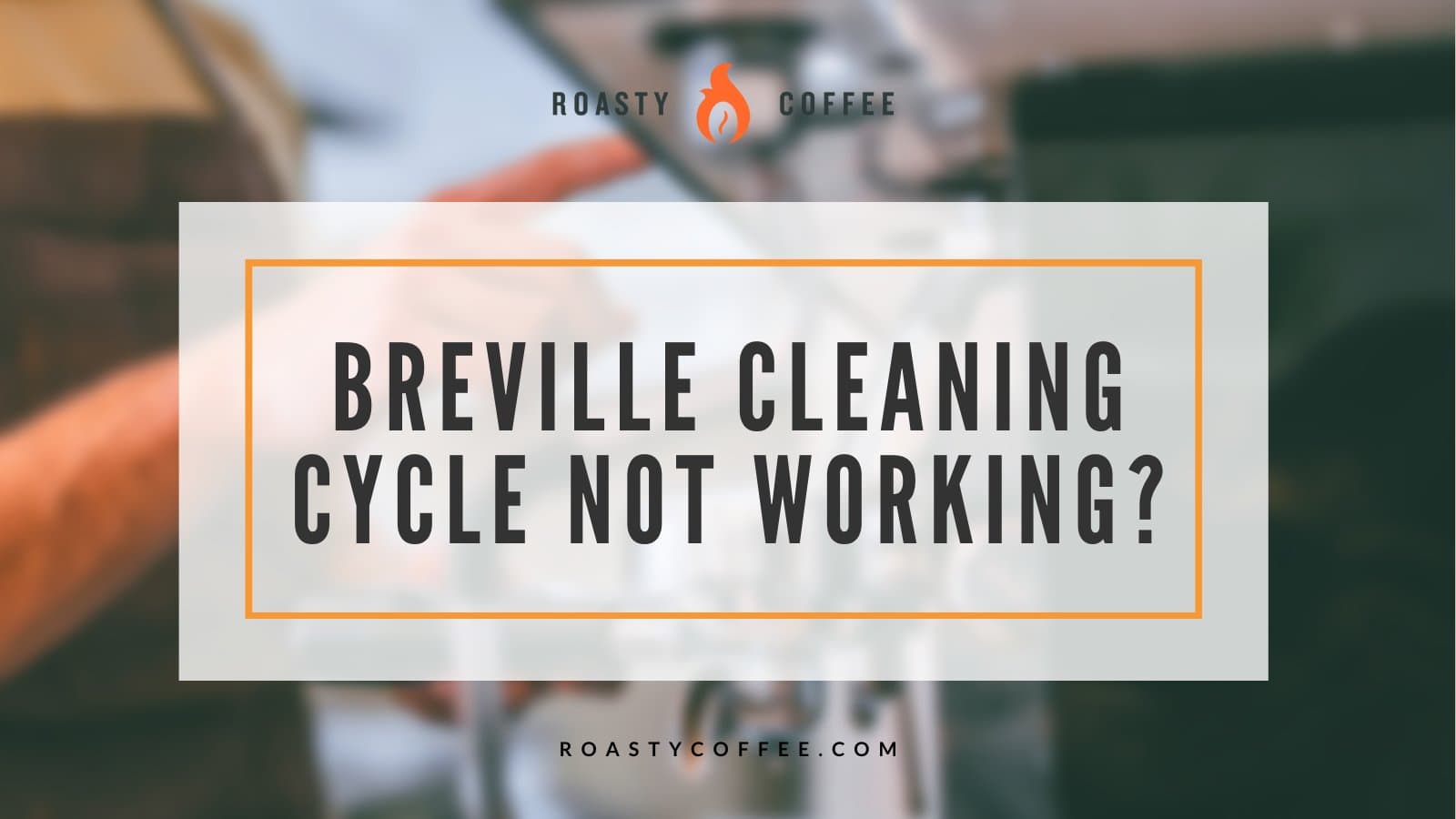Many of you probably have a Breville espresso machine on your kitchen counter. That’s not surprising; Breville is a trustworthy brewer brand.
Some Breville machines have a built-in cleaning cycle — good news since regular cleaning is the key to ensuring your appliance brews delicious cups of coffee for a long time.
Unfortunately, no brewer works 100 percent all the time. There’s a chance the cleaning cycle on your beloved Breville could stop working correctly. If that happens, you need to know how to fix it.
After all, your daily dose of caffeine depends on it.

What Is a Cleaning Cycle?
During an espresso machine automatic cleaning cycle (sometimes, cleaning cycles are called backflush cycles; we’ll be using the two terms interchangeably), water and cleaning solution is forced through the machine, pushing out any coffee oil or grounds that have built up.
Running the backflush cycle is essential for brewer owners, as removing buildups keeps your coffee tasting great and your machine from getting damaged.
How Do You Run a Cleaning Cycle?
It’ll be hard to spot a malfunction in the cleaning cycle unless you know how it should work.
You’ll find a complete walkthrough of your Breville espresso machine’s cleaning cycle in its instruction manual. But generally, the process for keeping your espresso machine clean is the same across the brand’s model.
- First, insert a filter basket, cleaning disc, and backflush tablet into the espresso machine’s portafilter.
- Lock the portafilter into the group head — more details on what that is later.
- Empty the brewer’s drip tank and fill the water tank.
- Then, activate the machine’s flush cycle. How to do this varies depending on which Breville you have, so you’ll need to consult the instruction manual for step-by-step directions.
- When the machine shows the backflush cycle is complete, take out the portafilter and carefully examine it to see if the cleaning tablet fully dissolved. If it has, great; you’re all done! Run the cleaning cycle until the remaining cleaning solution dissolves if part of the tablet is still there. Once it’s gone, you’re ready to resume your regularly scheduled brewing.
Potential Problems With Your Breville Espresso Machine
A Breville espresso machine’s cleaning cycle might be running incorrectly — or worse, not at all! — for a few reasons.
Roasty has researched a few common cleaning cycle problems and a few ways to solve them. Use these tips to clean your machine; they’ll get you back to pulling shots and creating latte art before you know it!
The Problem: You’re Using the Wrong Cleaning Solution
Most coffee enthusiasts know keeping a brewer on a regular cleaning schedule is necessary.
But consistency isn’t enough. Pulling the best shots possible, whether with a Breville machine or something else, won’t happen without the right cleaning solution.
The Solution: Keep your Machine Clean With a Better Product
It’s easy to let a lower price tag convince you to buy an improper cleaning solution. But trust us when we say springing for the good stuff — i.e., something directly from the machine’s manufacturer — is worth it.
Pairing a Breville cleaning solution with a Breville brewer gives you a clean machine and helps keep it producing lots of coffee for years.
Some off-brand cleansers can leave built-up coffee oils and coffee ground residue behind. But that’s not even the worst of it. These products sometimes contain harsh chemicals that damage the appliance’s internal parts.
The Problem: You Have the Wrong Flushing Disc
The cleaning disc, also called a backflush disc, might cause poor cleaning performance.
Using the wrong size disc with your Breville espresso machine will almost certainly cause problems, so choose one with a similar diameter to your portafilter. Something too big or too small impacts the water pressure and flow, keeping the backflush cycle from doing what it should.
Size matters when selecting backflushing discs, but so does variety. The wrong type of disc can prevent the espresso machine from backflushing.
Newer, more modern Breville brewers require a blind disc; that’s one with no relief hole in the center. However, discs designed for older models have holes in the center that let water and air flow through. You’ll need to know which kind of disc your machine can handle.
The Solution: Choose the Right Kind + Size of Backflush Disc
Disc problems are usually easy to fix. All you have to do is:
- Figure out what kind of disc your machine has to have. Consult your espresso maker’s instruction manual or contact Breville’s customer support center to determine whether older or more modern discs are better for your brewer.
- Match the disc and portafilter diameters. A backflush disc that’s too large or small means poor water pressure and, in turn, an ineffective cleaning cycle.
The Problem: The Valve Is Damaged
An espresso machine solenoid valve’s job is to control water flow throughout the appliance.
Since accurate water flow is a crucial part of backflushing, it shouldn’t be surprising to learn that faulty valves cause problems here.
Your beloved Breville won’t hesitate to tell you about valve issues. Look for:
- Buzzing or chattering noises
- Leaking
- No click (Valves have distinct clicking sounds; if you don’t hear one, assume the valve isn’t opening.)
The Solution: Descale the Machine or Replace the Valve
Sure, a faulty valve is inconvenient. But it’s a common issue, and fixing it is relatively easy.
Using a descaling solution should be your first course of action. If the valve is clogged, this should do the trick, and water flow will resume as usual.
But sometimes, the issue is more than just clogged coffee grounds. A valve worn out or damaged beyond repair can malfunction, and in those cases, you’ll need to replace the part before you can get back to brewing.
Stay ahead of valve issues by performing regular brewer maintenance. That means descaling every three to four weeks if water hardness is an issue in your area or every three to four months if you live in a soft water area.
The Problem: The Group Head Is Clogged
A clogged coffee machine head is another common reason for a failing cleaning cycle.
The head — you might also hear it called a group head, group, espresso machine group, brew group, or brew head — is responsible for the great-tasting coffee your appliance produces; the group brings hot, pressurized water to your coffee puck.
Unfortunately, brew groups are susceptible to coffee or mineral buildup. When left unattended, the accumulation of water minerals of coffee oils can mess with your espresso maker’s brew and backflush cycles, standing between you and the cup of coffee you sip every morning and keeping you from having a clean machine.
The Solution: Clean the Group Head.
Giving the group a little TLC can go a long way.
Replace the group head’s shower screen periodically; no matter how meticulous your cleaning routine is, coffee oils will build up and eventually clog it.
It’s time to switch the screen when your usually high-quality espresso shots start tasting a little off or when water sprays sporadically instead of in a constant stream.
Keep the shiny new shower screen and the rest of the group in tip-top shape by cleaning this part of your brewer at least monthly.
- Turn off the espresso machine.
- Remove the portafilter and shower screen.
- Soak the screen in a bowl of water. Then, wipe it with a damp paper towel or soft rag.
- Then, use the paper towel to wipe any coffee residue off the bottom of the group.
Frequently Asked Questions
How Often Should You Backflush Your Espresso Machine?
Commercial espresso machines (those used in retail settings) need backflushing at the end of every day.
Flushing with plain water might be enough on a slow day. But generally, using chemicals designed for backflushing is a good idea.
Flush your home espresso coffee machine at least once a week. However, making backflushing part of your daily cleaning regime won’t hurt. You don’t necessarily need to use chemicals each time, but running plain water through the brewer once you’ve finished using it is a good habit to build.
How Do I Reset My Breville After a Cleaning Cycle?
You might notice that the “Clean Me” light sometimes stays on even after you run the cleaning cycle.
This is a sign you might have skipped one of the cleaning steps or completed them out of order. Your machine might be a little confused, thinking it’s still dirty even if it isn’t.
Resetting a Breville brewer post-backflush cycle varies depending on the model, so your best bet is to see what your appliance’s instruction manual says or contact Breville support.
How Often Should You Run the Breville Cleaning Cycle?
File this bit of cleaning advice in your mind: run your Breville espresso machine’s cleaning cycle once every two to three months or per 200 shots of espresso brewed.
Keeping track of the days since your last cleaning or counting every espresso shot you pull sounds daunting?
Luckily, you don’t have to do either; the espresso maker will tell you via a notifier like a “Clean Me” light when it needs attention.
How Long Does a Breville Cleaning Cycle Take?
Numerous coffee lovers skip running their brewer’s cleaning cycle, fearing it’ll take too long.
Fortunately, you don’t have to worry about that with a Breville coffee maker. Since the built-in cleaning cycle on one of these brewers only runs for about five minutes, you’ll only have to pause your brewing routine briefly.
What Is the Difference Between Cleaning and Descaling a Breville?
Descaling and backflushing are essential parts of cleaning an espresso machine. Though they both serve the same purpose — keeping your beloved brewer functioning at its best — each does so differently.
Cleaning/backflushing removes coffee buildup (used coffee grounds and bean oils) from the machine’s group head. This process helps water flow through the brewer and improves the taste of the shots you pull.
Descaling, on the other hand, focuses on cleaning the water tank. Descaling solutions, usually made from citric acid, break down mineral buildup.
Get Your Brewer Back on Track
Don’t abandon your handy-dandy Breville brewer just because the backflush cycle has gone kaput.
Use the above tips to troubleshoot and solve the problem. Then, before you know it, you’ll be back to brewing great-tasting espresso.
If none of our fixes get you back to business, it’s a good idea to let a professional technician look at it or take advantage of Breville’s customer support service.
Happy Caffeinating!








